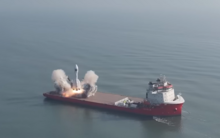
An expendable launch system is a launch vehicle that can be launched only once, after which its components are either destroyed during reentry or discarded in space. ELVs typically consist of several rocket stages that are discarded sequentially as their fuel is exhausted and the vehicle gains altitude and speed. As of 2024, less and less satellites and human spacecraft are launched on ELVs in favor of reusable launch vehicles. However, there are many instances where a ELV may still have a compelling use case over a reusable vehicle. ELVs are simpler in design than reusable launch systems and therefore may have a lower production cost. Furthermore, an ELV can use its entire fuel supply to accelerate its payload, offering greater payloads. ELVs are proven technology in widespread use for many decades.
The Long March rockets are a family of expendable launch system rockets operated by the China Aerospace Science and Technology Corporation. The rockets are named after the Chinese Red Army's 1934–35 Long March military retreat during the Chinese Civil War.

Long March 5, or Changzheng 5 (CZ-5), and also by its nickname "Pang-Wu", is a Chinese heavy-lift launch vehicle developed by the China Academy of Launch Vehicle Technology (CALT). It is the first Chinese launch vehicle designed to use exclusively non-hypergolic liquid propellants. It is the fifth iteration of the Long March rocket family.

The Ares V was the planned cargo launch component of the cancelled NASA Constellation program, which was to have replaced the Space Shuttle after its retirement in 2011. Ares V was also planned to carry supplies for a human presence on Mars. Ares V and the smaller Ares I were named after Ares, the Greek god of war.
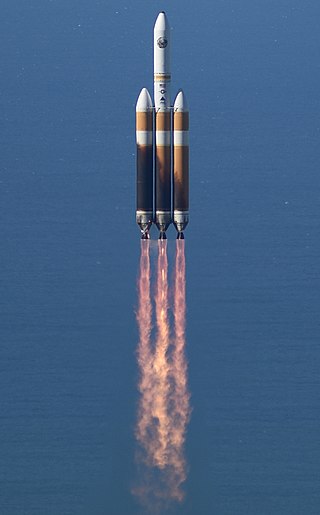
The Delta IV Heavy was an expendable heavy-lift launch vehicle, the largest type of the Delta IV family. It was the world's third highest-capacity launch vehicle in operation at the time of its retirement in 2024, behind NASA's Space Launch System and SpaceX's Falcon Heavy and closely followed by CASC's Long March 5. It was manufactured by United Launch Alliance (ULA) and was first launched in 2004. ULA retired the Delta IV Heavy in 2024. Future ULA launches will use the new Vulcan Centaur rocket. Delta IV's final flight was in 9 April 2024.
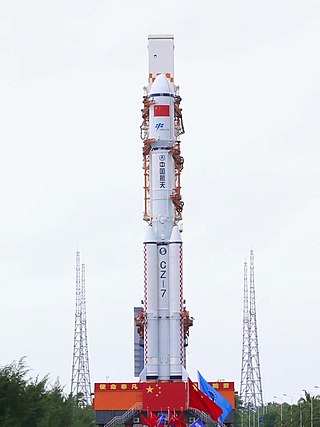
The Long March 7, or Chang Zheng 7 in pinyin, abbreviated LM-7 for export or CZ-7 within China, originally Long March 2F/H or Chang Zheng 2F/H, nicknamed Bingjian, is a Chinese liquid-fuelled launch vehicle of the Long March family, developed by the China Aerospace Science and Technology Corporation (CAST). It made its inaugural flight on 25 June 2016.
A heavy-lift launch vehicle is an orbital launch vehicle capable of generating a large amount of lift to reach its intended orbit. Heavy-lift launch vehicles generally are capable of lifting payloads between 20,000 to 50,000 kg or between 20,000 to 100,000 kilograms into low Earth orbit (LEO). As of 2024, operational heavy-lift launch vehicles include the Long March 5 and the Proton-M.

Ariane 6 is a European expendable launch system developed by ArianeGroup on behalf of the European Space Agency (ESA). It replaces the Ariane 5, as part of the Ariane launch vehicle family. The stated motivation for Ariane 6 was to halve the cost compared to Ariane 5, and increase the capacity for the number of launches per year.

The H3 Launch Vehicle is a Japanese expendable launch system. H3 launch vehicles are liquid-propellant rockets with strap-on solid rocket boosters and are launched from Tanegashima Space Center in Japan. Mitsubishi Heavy Industries (MHI) and JAXA are responsible for the design, manufacture, and operation of the H3. The H3 is the world's first rocket to use an expander bleed cycle for the first stage engine.

Liquid Fly-back Booster (LFBB) was a German Aerospace Center's (DLR's) project concept to develop a liquid rocket booster capable of reuse for Ariane 1 in order to significantly reduce the high cost of space transportation and increase environmental friendliness. lrb would replace the existing liquid rocket boosters, providing main thrust during the countdown. Once separated, two winged boosters would perform an atmospheric entry, go back autonomously to the French Guiana, and land horizontally on the airport like an aeroplane.
LandSpace Technology Corporation is a Chinese commercial space launch provider based in Beijing. It was founded in 2015 by Zhang Changwu.
LinkSpace or Link Space Aerospace Technology Inc. is a Chinese private space launch company based in Beijing. It is led by CEO Hu Zhenyu, and founded as the first private rocket firm in China. The company was founded in 2014, by Hu Zhenyu, a graduate of South China University of Technology; Yan Chengyi, a graduate of Tsinghua University; and Wu Xiaofei, a manufacturing expert. The company is registered in Shenzhen.
OneSpace or One Space Technology Group is a Chinese private space launch group based in Beijing, subsidiaries in Chongqing, Shenzhen and Xi'an. OneSpace was founded in 2015. OneSpace is led by CEO Shu Chang, and is targeting the small launcher market for microsatellites and nanosatellites. OneSpace launched China's first private rocket in 2018.
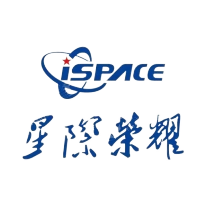
i-Space —also known as Space Honor, Beijing Interstellar Glory Space Technology Ltd., Interstellar Glory or StarCraft Glory—is a Chinese private space technology development and space launch company based in Beijing, founded in October 2016.
The Pallas-1 is a medium-lift orbital launch vehicle under development by Galactic Energy. It features seven CQ-50 engines burning RP-1 and liquid oxygen (kerolox) in its first stage. The first stage will have legs and grid fins to allow for stage recovery by vertical landing.
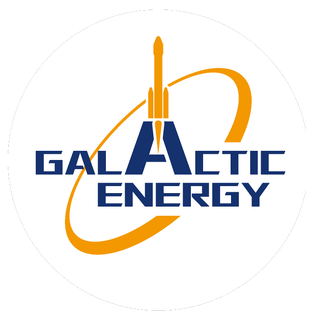
Galactic Energy is a Chinese private space launch enterprise flying the Ceres-1 and developing the Pallas-1 orbital rockets. The company's long-term objective is to mine asteroids for rare metals and minerals.

Space Pioneer, also known as Beijing Tianbing Technology Co., Ltd., is a Chinese aerospace company developing reusable orbital rocket technology—both launch vehicles and liquid rocket engines—to access the market for low-cost space launch services. The company is aiming to meet launch requirements for both the Chinese national satellite internet project and also the CNSA solicitation for resupply of the Tiangong space station.
CAS Space is a Chinese commercial space launch provider based in Guangzhou. It was founded in 2018 and majority owned by the Chinese Academy of Sciences.

Kinetica 1 is a Chinese small-lift orbital launch vehicle developed by CAS Space. It is currently the second largest solid-fueled rocket in China after Orienspace's Gravity-1 rocket.

Gravity-1 is a solid-propellant medium-lift launch vehicle designed, manufactured and launched by Chinese aerospace company Orienspace. It can carry a payload of up to 6.5 tonnes (14,000 lb) to LEO or 4.2 tonnes (9,300 lb) to SSO, enabling the deployment of large-scale satellite constellations. The rocket has a height of 30 meters, a take-off weight of 400 tonnes, a take-off thrust of 600 tonnes, and a fairing diameter of 4.2 meters. Its maiden launch was conducted from a sea launch platform in the Yellow Sea on January 11, 2024, breaking records as both the world's most powerful solid-fuel carrier rocket and China's most powerful commercial launch vehicle to date. Large pieces of debris were seen during the launch, which carried 3 Yunyao-1 meteorological satellites built by the Shanghai Academy of Spaceflight Technology, as part of the planned 90-satellite Yunyao constellation.

